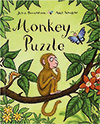
Download the PDF of this article
While Julia Donaldson is best known for The Gruffalo, she has written many other children’s books that are worth sharing with children.
 In this book, a baby monkey is looking for his mother. A friendly butterfly takes charge and tries to solve the puzzle of where she might be.
In this book, a baby monkey is looking for his mother. A friendly butterfly takes charge and tries to solve the puzzle of where she might be.
Unfortunately, the baby monkey doesn’t give a full description of his mother and so butterfly takes the baby monkey to the wrong animal over and over again. When the baby monkey finally explains that he looks like his mother, the puzzle is nearly solved.
Register now to continue reading
Thank you for visiting Nursery World and making use of our archive of more than 35,000 expert features, subject guides, case studies and policy updates. Why not register today and enjoy the following great benefits:
What's included
-
Free access to 4 subscriber-only articles per month
-
Unlimited access to news and opinion
-
Email newsletter providing activity ideas, best practice and breaking news
Already have an account? Sign in here









